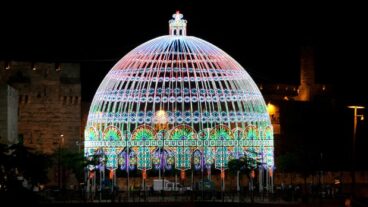For years, whenever I have driven down King George Street, near the Great Synagogue and the Leonardo (formerly Sheraton) Plaza Hotel, the building at the corner with Agron Street has pained me – a tremendously ugly, 7-story, dilapidated monstrosity that I have waited patiently for some announcement of its pending demolition that never comes.
And now I learn that the building was not only once considered a paradigm of daring optimism and ”modernity,” but the architect behind it has become one of the most celebrated in the country’s history.
That’s not to say that the Amir Center (as the building is officially called) won’t someday be torn down to build another luxury apartment tower; other high-rise buildings have already been approved in its immediate surroundings. But a retrospective, almost loving article in today’s Haaretz may temper those ambitions.
In 1958, architect David Resnick was asked to design a new residential building at the intersection in question. In an interview, he praised its innovations, which broke out of the classic Jerusalem Stone look and feel to splash a dose of modernist paint on the city. The Amir Center was built on a large 10 dunam plaza, its 7 floors propped up on stilts, with a Supersol supermarket (the first in Jerusalem) down below.
While Resnick was pleased with his creation (it even won an award in 1963 for technological innovation), the building was immediately dubbed “Jerusalem’s ugliest building” in street interviews that took place at the time, Haaretz reports.
That controversy, however, helped raise Resnick’s public visibility, and the architect went on design such more acclaimed Jerusalem landmarks as the dome shaped synagogue on Hebrew University’s Givat Ram campus, the Mormon Center on Mount Scopus and the Van Leer Institute, among many other always-modernist style projects.
That said, Resnick admits that the Amir Center has been “modified” beyond its original clean lines: residents have enclosed balconies, added unattractive air conditioning units. Indeed, Resnick says “When I walk past the building today, I look the other way. I can’t bear to see what they did to it.
The city is promoting a plan where a contractor is given the rights to build an extra floor or two at no cost provided the residents’ current living space is upgraded (including making it earthquake proof). But the building’s shell, apparently, isn’t strong enough to bear the additional weight, so for now, it’s either demolish or stay ugly.
While “to date no plan has been formulated or submitted,” according to a municipality spokesperson, Resnick would undoubtedly be opposed. “The question of nice or not nice is irrelevant,” he says. “I think that the Israeli establishment does not understand what architecture is and its importance to the state.”
In another 50 years, will they be talking this way about the Holyland project too?









